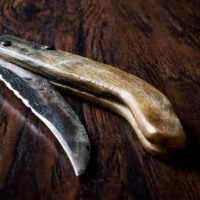CALIFORNIA AND OAKLAND KNIFE LAW

This article about knife laws is for informational purposes. It points out specific laws for the jurisdiction I mention in the article. It also lets you know you may have to check on a particular jurisdiction’s (i.e. city, county, state) statutes, ordinances and rules to see if what you are carrying is legal. You can find these ordinances on the public entity’s website. I have received hundreds of inquiries and cannot answer them all so I encourage you to take a look on the relevant website.
|
Remember that carrying any weapon, even one that’s legal, can cause you a lot of grief with law enforcement. Cops routinely write tickets and make arrests for things they incorrectly think are illegal, or full well know not to be illegal. Beating a rap in court is great, but better is never being there in the first place. |
In California, the state knife laws are the baseline law, and cities can make more restrictive knife laws on top of the state laws. See Yuen v. Municipal Court (1975) or People v. Gerardo (1985). Since we’ve addressed the state laws in other entries in this series, this synopsis places the Oakland knife laws first, and then outlines below the state laws that form the baseline rules.
OAKLAND KNIFE LAWS
In addition to all of the state laws outlined below, Oakland has voted knife restrictions that are significantly more stringent than the state’s laws. In Oakland, all of the following are classified as a “dangerous weapon”: (1) any knife with a blade three inches or longer; (2) any snap-blade or spring-blade knife regardless of the length of the blade; (3) any ice pick or similar sharp stabbing tool; (4) any cutting, stabbing or bludgeoning weapon or device capable of inflicting grievous bodily harm; (5) any dirk, dagger or bludgeon (the state law section has definitions of these). See Oakland Municipal Code § 9-36.010.
Regardless of state law, it is illegal in the city of Oakland to carry a “dangerous weapon” as defined above, whether open or concealed, or even to have one under your control (for instance, in your saddlebag or under the seat of your car). See OMC § 9-36.020. As usual, there is an exception for knives you carry for purposes of a lawful occupation or lawful recreation. See § 9-36.020. All switchblades, including anything with a spring or snap mechanism of any sort, are illegal to possess, sell or use in any way whatsoever, ie. there’s no lawful exception for work or recreation. See § 9-36.040. If you’re in an Oakland city park, the only knife you’re allowed to carry without permission from the Parks Board is a pocket knife. See § 12-64.020.
If you get into a fight in Oakland or get into a “rough or disorderly conduct” situation (and that can cover a lot of things), and you’re carrying a blade classified as a “dangerous weapon,” you’ll be charged – at a minimum – with a separate disorderly conduct violation in addition to the knife charge. See § 9-36.030.
All of the above described violations are classified as misdemeanors, punishable by up to 6 months in the slammer, a $1,000 fine, or both the time and the fine.
In addition to these, Oakland goes further than most other cities in California in their use of civil actions to combat people they view as criminals. In 2004, the city government came up with a plan to fight gangs and crime by leveraging their legal control of the eviction process. To wit, they came up with a plan to systematically take action to evict people who had broken laws and municipal ordinances. This plan was codified in law as Oakland Municipal Code Chapter 8, section 23.100, the “Eviction for Nuisance and Illegal Activity Ordinance.” Here’s what this ordinance is, how it works, and what it has to do with knife laws.
Municipal Code § 8-23.100 was created to expand the illegal activities that can be used to require landlords to bring eviction actions against individuals, to penalize owners for allowing undesirable people and behavior on their property, to authorize the City to take other action against the rental property owner when he won’t act, to enable rental property owners to let the City itself take over the eviction action, to single out the specific person instead of everyone on the premises, and to create a quick and easy process to do all of the above. See § 8-23.100(A).
Under this ordinance, the category of “weapon” includes all “deadly weapons” as defined in California BPC § 7500.1(h), which lists slungshots, metal knuckles, dirks, daggers, and any knife with a blade longer than five inches. See § 8-23.100(B).
In Oakland, by this ordinance, all leases between landlord and tenant automatically include a provision that prohibits all illegal activity on the premises, including illegal possession of a weapon as defined under above. See § 8-23.100(C). Under § 8-23.100(C) and § 8-23.100(D), any tenant who violates this prohibition or allows a violation is automatically subject to eviction under Oakland’s ‘Just Cause’ eviction section, § 8-22.360. Let me repeat that: if you violate this ordinance by possessing, say, a slungshot or a knife with a 5″ blade, in your own home or shop, you’re open to the eviction process outlined in the ordinance.
When the landlord learns about the violation, he’s barred from allowing the person to continue violating the ordinance, and he himself becomes on the hook with the city for fines, so he has three options. See § 8-23.100(D). First option is that he can ensure that the tenant stops violating, second option is that he can take action to evict the tenant, and the third option is that he can notify the city and ask them to take action to evict the tenant. See § 8-23.100(D)-(F). If the owner doesn’t take action within a specified amount of time, he can be liable for fines. See § 8-23.100(F).
What this means for knife law is that in Oakland, it’s possible for you to be evicted from your rented home or business if you’re keeping illegal knives on the premises. The case where this is most likely to occur would be in clubhouses, or places where people carrying illegal weapons are hanging out most often, but theoretically it could happen anywhere in the city that you rent from a landlord. If you’re renting a place, and you’ve had cops take you or someone else away on a dangerous weapon charge for, say a slungshot or a long blade, take care that you don’t get a second offense that triggers action by the landlord and/or the City. In Oakland, there’s iron in the glove, they have a lot of power under § 8-23.100, and so far the courts have not found anything in the exercise of this power to be unconstitutional.
CALIFORNIA
Here are the baseline knife laws in California.
Concealed Knives, Dirks, and Daggers – Penal Codes § 12020, § 20200 & § 21310
In California, folded pocked knives are legal, but it is illegal for any person to concealed carry any knife legally described as a “dirk” or “dagger” — the legal terms for any fixed-blade knife or stabbing weapon. See § 12020(4). Even a locked pocket knife can count, so can a screwdriver in some cases. See § 16470. BUT carrying a “dirk” or “dagger” in an openly-worn sheath hanging on your hip is not concealment within the meaning of the statute. See § 12020(25)(d) and § 20200.
Switchblades – Penal Codes § 17235 & 21510
Switchblades and other spring-loaded knives are illegal in California if their blade is 2″ or longer. A switchblade is a knife with “the appearance of a pocketknife and includes a spring-blade knife, snap-blade knife, gravity knife, or any other similar type knife, the blade or blades of which are two or more inches in length and which can be released automatically by a flick of a button, pressure on the handle, flip of the wrist or other mechanical device, or is released by the weight of the blade or by any type of mechanism whatsoever.” See § 17235. The statute expressly excludes pocket knives that can be opened with one hand by pushing the blade open with one’s thumb, as long as the knife “has a detent or other mechanism that provides resistance that must be overcome in opening the blade, or that biases the blade back toward its closed position.” See § 17235. Basically, your regular pocket knife is legal, and switchblades are legal if they’re under 2″.
The law is zero tolerance on these, and they’ll bang you with a misdemeanor charge if you: (a) possess the knife in the passenger’s or driver’s area of any motor vehicle in any public place or place open to the public; (b) carry the knife upon the person; (c) sell, offer for sale, expose for sale, loan, transfer, or gives the knife to any other person. See § 21510. The Court of Appeals held that possession of a switchblade in a person’s pocket, boot, etc., is unlawful, even if even if in one’s own home. See People v. S.C. (2009). Modifying a pocket knife into a switchblade-like knife makes it a switchblade. See People v. Angel R. (2008).
Cane Swords and other Disguised Blades – Penal Codes § 16590
Generally, any knife or blade that is disguised so as to not look like a weapon is also illegal in California. See § 16590. This includes, cane swords (§ 16340), belt-buckle knives (§ 16260), lipstick case knives (§ 16830), air gauge knives (§ 16140), writing pen knives (§ 17359), so-called ballistic knives (§ 16220), a staff or crutch (§ 17260), etc. Blades that are undetectable to metal detectors (e.g., ceramic blades) are also illegal. See § 20810 and § 17290. Remember, just because your blade isn’t explicitly described under the law, doesn’t mean the cops can’t find some way to write you up under the closest description. I once had a client wearing rings the police magically made into “metal knuckles” under PC § 21810 because he was wearing a cut. They also used the cut to add a gang enhancement to the “weapon” of rings, sorry, “metal knuckles.”
Possession of Knives on School Grounds – Penal Code § 626.10
It is illegal for any person to bring or possess “any dirk, dagger, ice pick, knife having a blade longer than 2 1/2 inches, folding knife with a blade that locks into place, [or] razor with an unguarded blade . . . upon the grounds of, or within, any public or private school providing instruction in kindergarten or any of grades 1 to 12 . . .” See § 626.10(a)(1). Subsection (b) of the statute provides that it is illegal for any person to possess “any dirk, dagger, ice pick, or knife having a fixed blade longer than 2 1/2 inches upon the grounds of, or within, any [college or university].”
Possessing a Knife in a Government Building – Penal Code § 171b
Legal blades 4″ or longer that are fixed or capable of being fixed are illegal within any state or local public building or at any meeting required to be open to the public. See § 171b(A)(3). Here, a “state or local public building” is a building that is owned or leased by the state or local government, with state or local public employees working on a regular basis. See § 171b(C)(1).
Brandishing Knives – Penal Code § 417
In California, it is illegal to brandish any deadly weapon, knives included. See § 20200-21590 broadly. The law states that it is unlawful for any person to “draw or exhibit any deadly weapon . . . in a rude, angry, or threatening manner, or . . . to unlawfully use a deadly weapon.” See § 417(A)(1). This does not include use of such a weapon in self defense. See § 417(A)(2). Watch out, there is a mandatory minimum on this one of thirty days, in addition to anything else they nail you for. See § 417(A)(1).
So that’s where we stand! Tune in next time to learn about knife laws in Alameda County.
Bill Weiss has long experience in personal injury and civil rights cases on behalf of the motorcycle community. He is one of the only attorneys in California that represents bikers in civil rights cases against law enforcement. He has recovered millions of dollars on behalf of his clients who have been injured in motorcycle collisions and other personal injury cases, as well as civil rights cases.


